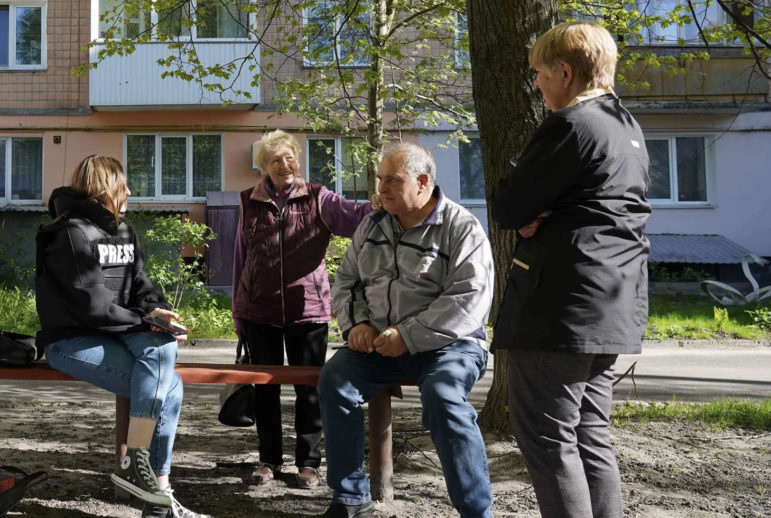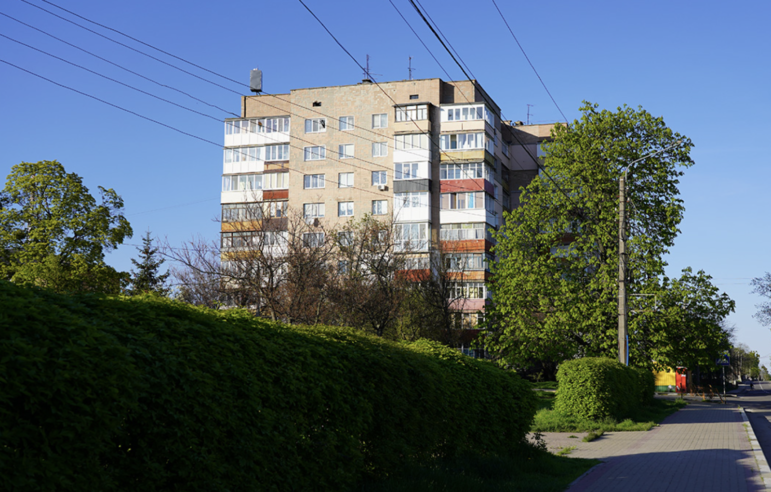

Using Telegram Chats to Reveal Life in Bucha Under Russian Occupation
Read this article in
Reporters at the Organized Crime and Corruption Reporting Project (OCCRP) took a neighborhood Telegram chat from Bucha, in Kyiv Oblast, and turned it into a “Scrollytelling” feature story titled The Banality of Brutality: 33 Days Under Siege in Block 17, Bucha, Ukraine. This post was originally published on OCCRP’s Medium page and is reprinted here with permission.
“Who is on now? We need help to put out the fire on … 1st floor is on fire. Thanks to everyone who was able to put out the fire — you are heroes!”
As Slidstvo.info’s editor-in-chief Anna Babinets scrolled through Facebook one day this April, she saw a post from a Bucha resident. It was just a few sentences from a Telegram chat about life under siege during the Russian invasion, but we thought it might be interesting for our readers to know what people were writing in these chats during this time.
Like people around the world, many Ukrainians use these neighborhood group chats to solve daily problems, give advice, and connect with each other. I gained access to the full log of a chat from 88 people in one building, called Block 17, where the residents seemed to know each other well and were clearly close.
I was expecting to read about cruelty and horror — as our story says, Bucha has become a byword for brutality — because we know so much about what happened there. And there was certainly that, but fearful messages about bombings and gunfire were interspersed with texts that showed boredom, bickering, cooperation, and support for one another.
Since the start of the war, the journalists at Slidstvo have completely changed their focus from doing investigative stories on organized crime and corruption — typically a long game — to using their deep investigative skills to document and verify war crimes as quickly as possible. Our reporting has helped Ukrainian authorities identify Russian soldiers responsible for atrocities at Bucha and we helped build the largest database of Russian occupiers with almost 150,000 names. So we were becoming accustomed to thinking and working differently than we used to in order to exist as a media outlet in this new world. The chat was interesting, but we couldn’t see a clear end result and we initially thought that we might not be able to make anything out of it.
But OCCRP film director Matt Sarnecki and deputy editor in chief Julia Wallace were enthusiastic and saw how the chat log was a real-time snapshot of life during war and how people in the building related to each other — perhaps a modern version of a wartime letter. We framed the story as a glimpse of endurance and everyday life during this moment in time in this one building.
OCCRP’s tech team translated the enormous volume of messages into English (88 people x 33 days + being attacked = a lot of chatter). We created a folder with key screenshots on every topic (such as “Christmas lights episode,” “building on fire,” and “ Jack the cat”) and made a list of all the people who were involved in this chat. We chose 10 – 12 vivid events that stood out and were memorable.
Then, just as with the type of investigative reporting we’re used to doing, we worked to identify the people and events behind the snippets, keeping in mind OCCRP’s notoriously difficult fact-checking process.
In May, reporter Yana Korniychuk went to knock on doors to try to match the people with the messages and verify the content. Some people used nicknames and some had been communicating in the chat from outside the city. Plus, we had no idea if people would even want to talk to us at all.
Korniychuk found residents who were afraid — no one knew if the Russians were coming back — and some asked not to have their names used. But she gained their trust and found many people who wanted their story told.
Like some neighborhood chats, there were rumors and falsehoods swirling around, made more difficult because the residents were essentially cut off from outside news and information during this time.
A text about a pair of young women who were supposedly collaborating with the Russians turned out to be gossip and hearsay.
Everyone who worked on this story can attest that creating this feature was in many ways more challenging than publishing an investigation when it can be easier to discern concrete facts.
Next, we pulled in OCCRP’s design and web teams to strategize about what we would use and how we would tell this story. We landed on the scrollable format, using four elements: the log of the chat, the resident’s testimony after the fact, the context behind the events, and the visuals — photos and video.
We published our story in August and it was one of the most startling features ever to appear on OCCRP. We also sent the story to the original person who gave us access to the chat in the first place (who asked not to be identified).
What did they do with it? Posted it in the Block 17 Telegram chat, of course.
Additional Resources
How Journalists Can Investigate on Telegram
Tips for Archiving Telegram Messages on Russia-Ukraine War
Journalism Resources for Tracking Events in Ukraine
 Elena Loginova is an investigative reporter at OCCRP. She has been a team member on the Paradise Papers, FinCEN Files, and Pandora Papers projects. In 2021, she received the Ukrainian “Honor of Profession” award in the investigative journalism category for her documentary Break the Bank.
Elena Loginova is an investigative reporter at OCCRP. She has been a team member on the Paradise Papers, FinCEN Files, and Pandora Papers projects. In 2021, she received the Ukrainian “Honor of Profession” award in the investigative journalism category for her documentary Break the Bank.










